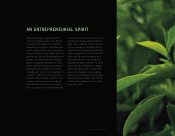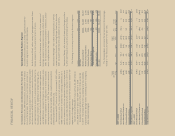Sara Lee 2011 Annual Report Download - page 51
Download and view the complete annual report
Please find page 51 of the 2011 Sara Lee annual report below. You can navigate through the pages in the report by either clicking on the pages listed below, or by using the keyword search tool below to find specific information within the annual report.
48/49 Sara Lee Corporation and Subsidiaries
The company’s international operations also provide a significant
portion of the company’s cash flow from operating activities, which
has required and is expected to continue to require the company to
repatriate a greater portion of cash generated outside of the U.S.
The repatriation of these funds has resulted in higher income tax
expense and cash tax payments.
In preparation for the spin-off, the corporation has identified
cost reduction opportunities of $180 million to $200 million, com-
pared to fiscal 2011, achievable within the next two years. These
cost reductions result from the downsizing of corporate resources,
the reduction of overhead within both the North American meat
businesses and the international coffee and tea businesses as well
as the completion of Project Accelerate initiatives. These savings
are expected to more than offset the $50 million to $60 million of
stranded costs from business dispositions.
In 2012, the corporation expects charges of approximately
$425 million relating to the above cost savings initiatives and other
actions. These costs are comprised of $300 million in restructuring
actions and $125 million for transaction-related costs.
Non-GAAP Measures Management measures and reports Sara Lee’s
financial results in accordance with U.S. generally accepted accounting
principles (“GAAP”). In this report, Sara Lee highlights certain items
that have significantly impacted the corporation’s financial results
and uses several non-GAAP financial measures to help investors
understand the financial impact of these significant items. The non-
GAAP financial measures used by Sara Lee in this annual report
are adjusted net sales, adjusted operating segment income, and
adjusted operating income, which exclude from a financial measure
computed in accordance with GAAP the impact of significant items,
the receipt of contingent sale proceeds, the impact of acquisitions
and dispositions, the impact of the 53rd week and changes in foreign
currency exchange rates. Management believes that these non-GAAP
financial measures reflect an additional way of viewing aspects of
Sara Lee’s business that, when viewed together with Sara Lee’s
financial results computed in accordance with GAAP, provide a more
complete understanding of factors and trends affecting Sara Lee’s
historical financial performance and projected future operating
results, greater transparency of underlying profit trends and greater
comparability of results across periods. These non-GAAP financial
measures are not intended to be a substitute for the comparable
GAAP measures and should be read only in conjunction with our
consolidated financial statements prepared in accordance with GAAP.
Challenges and Risks As an international consumer products
company, we face certain risks and challenges that impact our
business and financial performance. The risks and challenges
described below have impacted our performance and are likely
to impact our future results as well.
The food and consumer products businesses are highly
competitive. In many product categories, we compete not only with
widely advertised branded products, but also with private label prod-
ucts that are generally sold at lower prices. As a result, from time
to time, we may need to reduce the prices for some of our products
to respond to competitive pressures. Economic uncertainty may
result in increased pressure to reduce the prices for some of our
products, limit our ability to increase or maintain prices or lead to
a continued shift toward private label products. Any reduction in
prices or our inability to increase prices when raw material costs
increase could negatively impact profit margins and the overall
profitability of our reporting units, which could potentially trigger
a goodwill impairment.
Commodity prices directly impact our business because of their
effect on the cost of raw materials used to make our products and
the cost of inputs to manufacture, package and ship our products.
Many of the commodities we use, including beef, pork, coffee, wheat,
corn, corn syrup, soybean and corn oils, butter, sugar and energy,
have experienced price volatility due to factors beyond our control.
The company’s objective is to offset commodity price increases with
pricing actions and to offset any operating costs increases with
continuous improvement savings. During 2011, commodity costs,
excluding mark-to-market derivative gains/losses, increased approx-
imately $646 million over the prior year, including $55 million of
currency mark-to-market losses related to coffee purchases recognized
by the International Beverage segment. This increase in commodity
costs was only partially offset by approximately $468 million in
pricing actions. The company expects commodity costs to continue
to increase in 2012.
The company’s business results are also heavily influenced by
changes in foreign currency exchange rates. For the most recently
completed fiscal year, approximately 50% of net sales and operating
segment income related to continuing operations were generated
outside of the U.S. As a result, changes in foreign currency exchange
rates, particularly the European euro, can have a significant impact
on the reported results. A three cent movement in the euro exchange
rate is expected to have approximately a one cent impact on the
corporation’s diluted earnings per share.
























